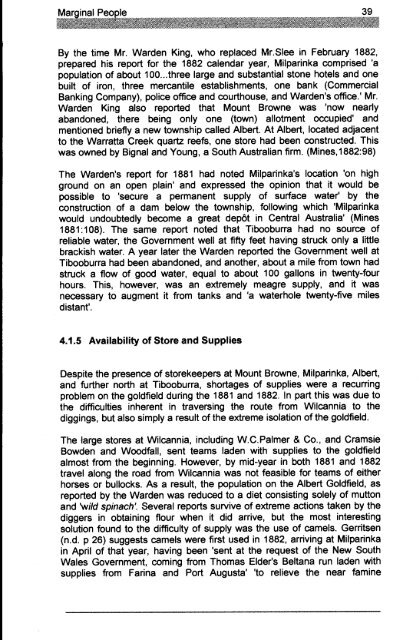Adec Preview Generated PDF File - The Sydney eScholarship ...
Adec Preview Generated PDF File - The Sydney eScholarship ...
Adec Preview Generated PDF File - The Sydney eScholarship ...
Create successful ePaper yourself
Turn your PDF publications into a flip-book with our unique Google optimized e-Paper software.
By the time Mr. Warden King, who replaced Mr.Slee in February 1882,<br />
prepared his report for the 1882 calendar year, Milparinka comprised 'a<br />
population of about 100...three large and substantial stone hotels and one<br />
built of iron, three mercantile establishments, one bank (Commercial<br />
Banking Company), police office and courthouse, and Warden's office.' Mr.<br />
Warden King also reported that Mount Browne was 'now nearly<br />
abandoned, there being only one (town) allotment occupied' and<br />
mentioned briefly a new township called Albert. At Albert, located adjacent<br />
to the Warratta Creek quartz reefs, one store had been constructed. This<br />
was owned by Bignal and Young, a South Australian firm. (Mines,1882:98)<br />
<strong>The</strong> Warden's report for 1881 had noted Milparinka's location 'on high<br />
ground on an open plain' and expressed the opinion that it would be<br />
possible to 'secure a permanent supply of surface water' by the<br />
construction of a dam below the township, following which 'Milparinka<br />
would undoubtedly become a great depot in Central Australia' (Mines<br />
1881:108). <strong>The</strong> same report noted that Tibooburra had no source of<br />
reliable water, the Government well at fifty feet haVing struck only a little<br />
brackish water. A year later the Warden reported the Government well at<br />
Tibooburra had been abandoned, and another, about a mile from town had<br />
struck a flow of good water, equal to about 100 gallons in twenty-four<br />
hours. This, however, was an extremely meagre supply, and it was<br />
necessary to augment it from tanks and 'a waterhole twenty-five miles<br />
distant'.<br />
4.1.5 Availability of Store and Supplies<br />
Despite the presence of storekeepers at Mount Browne, Milparinka, Albert,<br />
and further north at Tibooburra, shortages of supplies were a recurring<br />
problem on the goldfield during the 1881 and 1882. In part this was due to<br />
the difficulties inherent in traversing the route from Wilcannia to the<br />
diggings, but also simply a result of the extreme isolation of the goldfield.<br />
<strong>The</strong> large stores at Wilcannia, including W.C.Palmer & Co., and Cramsie<br />
Bowden and Woodfall, sent teams laden with supplies to the goldfield<br />
almost from the beginning. However, by mid-year in both 1881 and 1882<br />
travel along the road from Wilcannia was not feasible for teams of either<br />
horses or bullocks. As a result, the population on the Albert Goldfield, as<br />
reported by the Warden was reduced to a diet consisting solely of mutton<br />
and 'wild spinach'. Several reports survive of extreme actions taken by the<br />
diggers in obtaining flour when it did arrive, but the most interesting<br />
solution found to the difficulty of supply was the use of camels. Gerritsen<br />
(n.d. p 26) suggests camels were first used in 1882, arriving at Milparinka<br />
in April of that year, having been 'sent at the request of the New South<br />
Wales Government, coming from Thomas Elder's Beltana run laden with<br />
supplies from Farina and Port Augusta' 'to relieve the near famine




